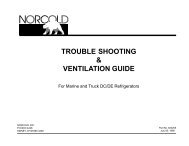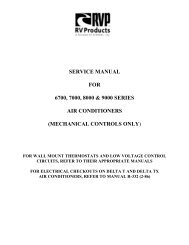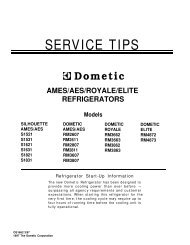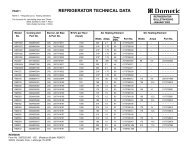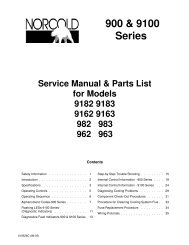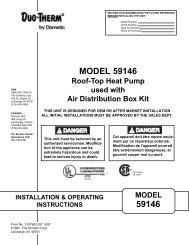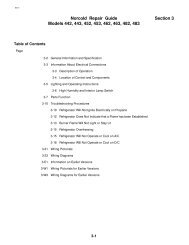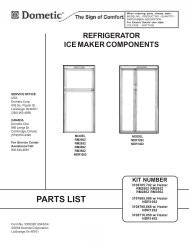Ducted analog/electronic installation manual (783 kb) - Bryant RV ...
Ducted analog/electronic installation manual (783 kb) - Bryant RV ...
Ducted analog/electronic installation manual (783 kb) - Bryant RV ...
Create successful ePaper yourself
Turn your PDF publications into a flip-book with our unique Google optimized e-Paper software.
ANALOG DUCTED INSTALLATION INSTRUCTIONS<br />
5. AIR DISTRIBUTION SYSTEM INSTALLATION<br />
A. The Dometic Corporation recommends the basic configuration shown on page 8, for installing this air conditioner/heat pump<br />
system. We have found by testing , that this configuration works best in most applications of this air conditioner/heat pump<br />
system. It is the responsibility of the Installer of this system to review each <strong>RV</strong> floor plan and determine the following:<br />
1. Duct size<br />
2. Duct layout<br />
3 Register size<br />
4. Register location<br />
5. Thermostat location<br />
These items must be determined in conjunction with the Air Distribution System and Sizing and Design Requirements listed<br />
in the chart on page 6.<br />
Important: Alternate configurations and methods may be used which still allow the air conditioner/heat pump<br />
to operate properly; however, these alternate configurations and methods must be approved by the Dometic<br />
Corporation in writing. The following instructions are based upon the use of Dometic Return Air Kits 3105007.XXX,<br />
3105935.XXX, or Genesis Air Filtration System 3308120.XXX. The 3107541.XXX and 3107546.XXX has the mounting<br />
bolts supplied for use with these kits.<br />
B. ROOF AND CEILING OPENING PREPARATION<br />
1. A 14-1/4" x 14-1/4" (±1/8") opening must be cut through the roof and ceiling of the <strong>RV</strong>. This opening must be located<br />
between the roof reinforcing members.<br />
!<br />
WARNING<br />
There may be electrical wiring between the<br />
roof and the ceiling. Disconnect 115 volt AC<br />
power cord and the positive (+) 12 volt DC<br />
terminal at the supply battery. Failure to follow<br />
this instruction may create a shock hazard<br />
causing death or severe personal injury.<br />
2. Mark a 14-1/4" x 14-1/4" (±1/8") square on the roof and carefully cut the opening.<br />
3. Using the roof opening as a guide, cut the matching hole in the ceiling.<br />
4. The opening created must be framed to provide adequate support and prevent air from being drawn from the roof cavity.<br />
Lumber 3/4" or more in thickness must be used. Remember to provide an entrance hole for power supply wiring and<br />
thermostat cable.<br />
5. The 14-1/4" x 14-1/4" (±1/8") opening is part of the return air system of the air conditioner/heat pump and must be finished<br />
in accordance with NFPA Standard 501C Section 2.7.<br />
6. Route a copper 12 AWG (max. length 24'), with ground, supply line from the fuse or circuit breaker box to the roof opening.<br />
a. This supply line must be located in the front portion of the 14-1/4" x 14-1/4" (±1/8") opening.<br />
b. The power supply MUST be on a separate Time Delay Fuse or HACR Circuit Breaker ( 20 amp for 579, 590, 591,59516<br />
and 600 series and 15 amp for 59529 and 59530.<br />
c. Make sure at least 15" of supply wire extends into the roof opening. This ensures easy connection at the junction<br />
box.<br />
d. Wiring must comply with all National, State and Local Wiring Codes.<br />
e. Use a steel sleeve and a grommet or equivalent methods to protect the wire where it passes into the opening.<br />
7. Route a DEDICATED 12V DC supply line (18–22 AWG) from the <strong>RV</strong>'s converter or battery to the roof opening. See Section<br />
6. Thermostat & Cable Installation, B. Cable Installation.<br />
a. This supply line must be located in the front portion of the 14-1/4" x 14-1/4" (±1/8") opening.<br />
b. Make sure that at least 15" of supply wire extends into the roof opening.<br />
7



